A downward ejection test from a B-47 Stratojet. This method was employed on a few aircraft, usually to help avoid an obstacle at the rear of the aircraft or above their station.
The Vultee XP-54 “Swoose Goose” was a futuristic and highly anticipated aircraft designed during the Second World War. Intended as a high-altitude escort fighter and later an interceptor, it was equipped with a turbo engine system considered quite advanced for its time.

Although its design was innovative and had features that were advanced for its time, only three prototype examples left the factory and the plane never entered the mass production phase with persistent engine problems hobbling its viability.
The effectiveness of existing fighters in the latter stages of the war further called into question the need for a plane like the XP-54.
The XP-54 originated from a specification put out by the United States Army Air Corps (USAAC) in November 1939 which was named specification R-40 C. The specification called for the design of a new fighter and interceptor aircraft that had superior speed, handling and pilot visibility compared to existing fighter aircraft.
Most importantly, the specification deliberately called for more experimental and unusual design features as the United States sought to establish itself at the forefront of fighter technology and not lag behind other nations in this area.
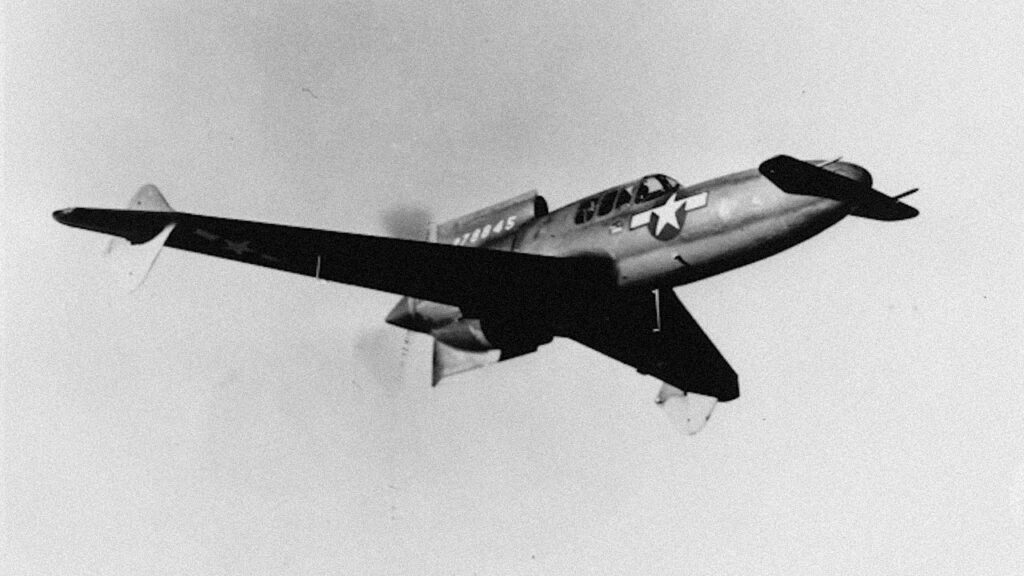 The Curtis-Wright XP-55 Ascender was also built in response to the R-40C requirement, and competed against the XP-54.
The Curtis-Wright XP-55 Ascender was also built in response to the R-40C requirement, and competed against the XP-54.
The USAAC wanted to allow designers and engineers room for creative freedom but also look for groundbreaking designs within that creativity to exploit and help America get ahead.
Read More Lun-class Ekranoplan: The Real Caspian Sea Monster
Three aircraft manufacturers: Curtiss-Wright, Northrop and the Vultee Aircraft Corporation all submitted design proposals to the USAAC. Vultee’s proposal was considered the winner of the three. A contracted was offered in 1941 for the company to develop a new prototype using new designs as they saw fit.
Development
Vultee provisionally named their new aircraft the Model 84 and began wind tunnel tests on two prototype models between 1941 and 1942. As per the R-40 C specification, the proposed model followed a more unconventional design and sought to try ideas that were revolutionary. Unlike other planes which featured a more traditional, straight-wing design, the prototype had a highly swept wing that was intended to optimize its aerial performance.
Despite experimenting with different ideas, test results proved to be subpar and Vultee continued to modify the design and brainstorm where to take it next.
 Rear fuselage of the XP-54 during wind tunnel testing.
Rear fuselage of the XP-54 during wind tunnel testing.
The final proposed idea for a prototype featured a pusher engine mounted behind the cockpit with the propeller at the rear of the plane. The tail was mounted between two wing booms (in a similar arrangement to the P-38) and the wings were a swept design. Vultee also sought to use the experimental Pratt & Whitney X-1800 engine as the power plant believing that combined with the swept wings, the plane would be faster and climb higher than its rivals.
Vultee intended for the new design to have, a cruising range of 500 miles and have the ability to reach a height of up to 37,000 feet. Vultee also designed the aircraft with a tricycle undercarriage system.
Perhaps the most remarkable feature of the aircraft was Vultee’s proposed method of loading the pilot. Instead of the pilot climbing into the aircraft’s cockpit on a ladder and stepping on the wing, the entire cockpit floor acted as a moveable platform and pilot’s seat could be electronically lowered to the ground.
 The XP-54’s seat mechanism, which lowered the pilot out from underneath the aircraft
The XP-54’s seat mechanism, which lowered the pilot out from underneath the aircraft
The pilot would then strap himself in and be raised up into the aircraft.
Vultee were satisfied with the design and went back to the military with their ideas.
By this point the USAAC had been renamed the United States Army Air Force (USAAF). The USAAF signed a contract for the Model 84 in January 1941.
Design of the XP-54
Vultee pressed ahead with their final design, keeping the twin-boom tail and swept wings. It was officially named the XP-54. It also acquired the nickname “Swoose Goose” due to its distinctive nose. The name came from the 1941 song “Alexander was a swoose”, which is about a man who is half-human and half-goose.
In addition, Vultee decided to add more to the prototype by fitting protective armor and self-sealing fuel tanks to the aircraft. Although these were standard features on many aircraft by the end of the war, these were considered advanced ideas at the time.
Read More Messerschmitt P.1101- German Forefather of the Swing Wing
Despite the impressive design features, the XP-54 also faced numerous technical difficulties during the development stage. The highly swept wing was challenging to control and the plane was found to suffer from stability problems at high speeds.
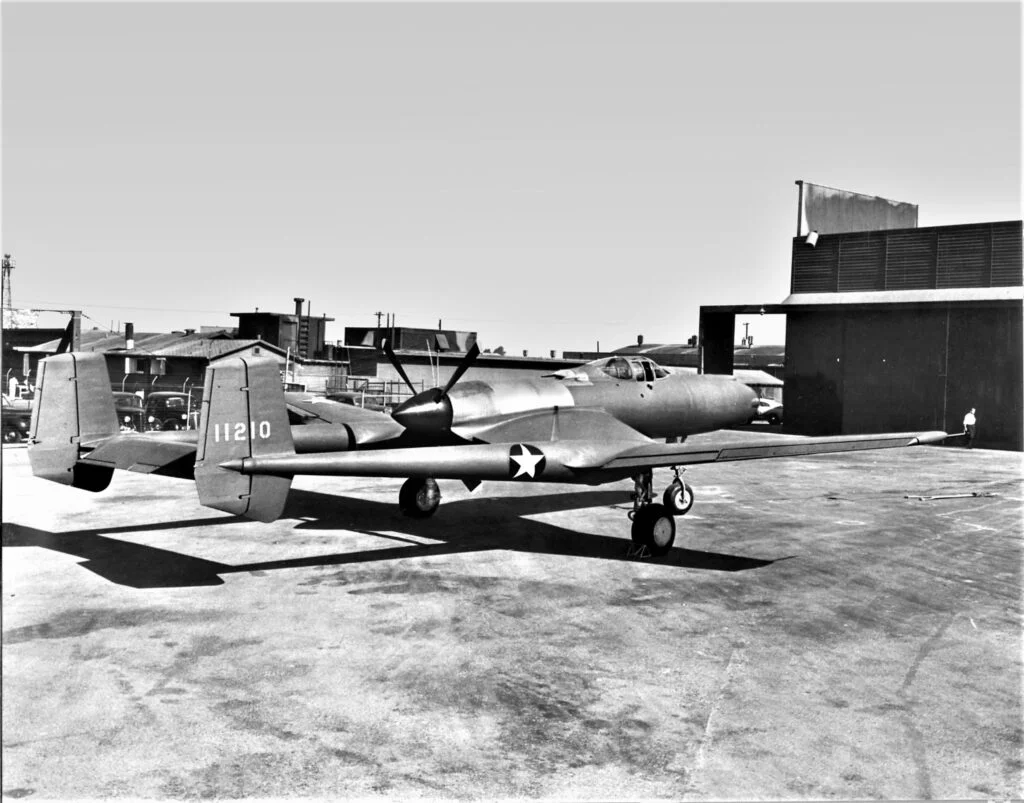 The aircraft’s unconventional layout proved to be challenging to fly.
The aircraft’s unconventional layout proved to be challenging to fly.
Vultee also proposed that the aircraft be armed with six Browning machine guns mounted in pivoting positions that would enable the pilot to strafe a target while maintaining level flight. Although a novel idea, tests resulted in complaints that the targeting system to operate the guns was too complex and added unnecessary weight to an already heavy plane.
Furthermore, Vultee then encountered difficulty when Pratt & Whitney terminated the X-1800 project. Instead, an untested Lycoming XH-2474 engine unit was fitted to the prototype. While the Lycoming engine was also liquid cooled and produced 2,300 horsepower, it was also a lot heavier than Vultee had intended for the airframe design and prompted further redesigning.
To compensate for the additional weight, allow the plane more lifting power and help it achieve high altitude performance, Vultee decided to fit a turbo supercharger for the engine which necessitated in pressurizing the cockpit and resulted in adding further weight.
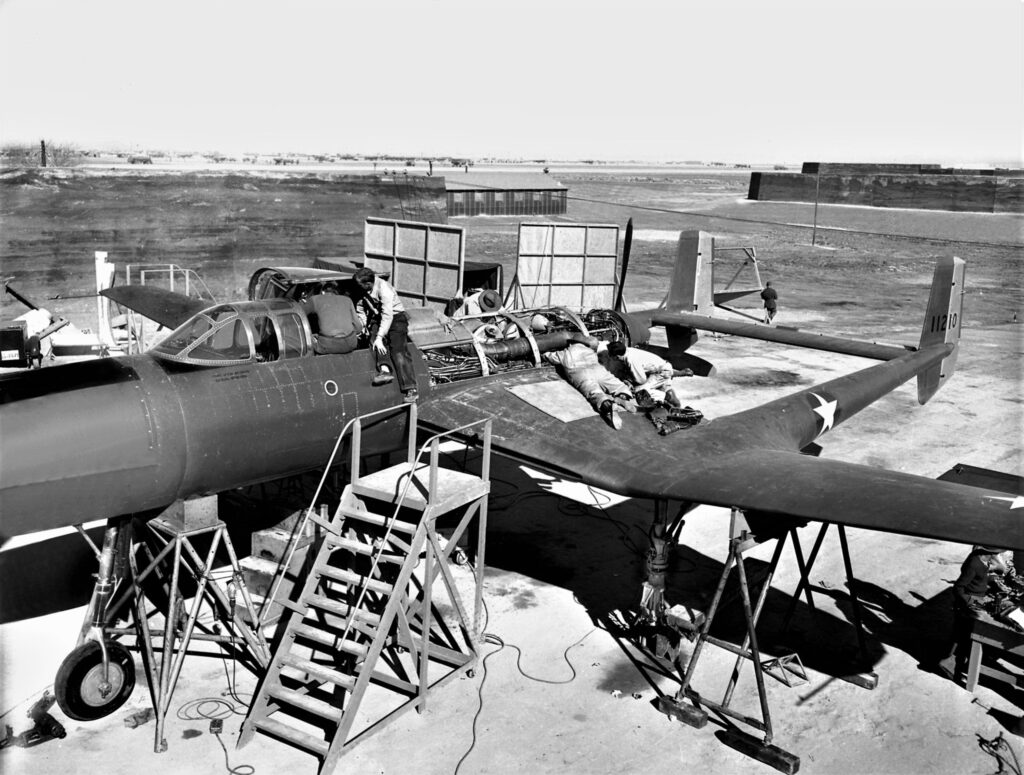 Aircrews work on the XP-54. Note the removed engine panels, and the main landing gear without wheels.
Aircrews work on the XP-54. Note the removed engine panels, and the main landing gear without wheels.
The advanced turbo supercharger system also proved to be problematic at times as it required a significant amount of maintenance to keep it functioning properly.
After conducting further research and studying other designs, Vultee decided to upgrade the XP-54’s weapons from machine guns to 37 mm cannons. While the cannons were more powerful and lethal against other aircraft, they also had a slower rate of fire so Vultee opted to maintain some of the machine guns and compliment them with the cannons, for a total of two 37 mm cannons and two .50 caliber machine guns.
Despite some of these setbacks, the USAAF ordered a second prototype in March 1942 and the XP-54’s intended combat use was changed from that of a fighter to a high altitude interceptor to exploit its speed.
 This is the magazine for the 37 mm cannons in the XP-54. It was specially designed for the aircraft by Colt, and had a capacity of 59 rounds.
This is the magazine for the 37 mm cannons in the XP-54. It was specially designed for the aircraft by Colt, and had a capacity of 59 rounds.
In 1943, the first XP-54 unit was ready for its maiden flight. It was dissembled and transported to the Mojave Desert where it was put back together. The maiden flight of the XP-54 took place on the 15th of January 1943.
Read More Vought V-173 – America’s Flying Pancake
Although the test flight was short and lasted half an hour, it quickly became clear to observers that the plane’s design had potential despite its troubled development. Its unique wing features and advanced turbo system allowed it to reach impressive altitudes and its combined weapon system indicated it could prove to be a formidable opponent in air-to-air combat.
A second test flight was scheduled at Wright Field in October 1943.
 XP-54 No. 11210, the first of the two prototypes.
XP-54 No. 11210, the first of the two prototypes.
Unfortunately, after managing to defy expectations with the first test flight, things started going wrong again for the XP-54. The plane’s Lycoming engine failed on takeoff and was damaged beyond repair. There was talk of replacing the Lycoming with the tried and tested Allison V-3420 engine, however Vultee knew that the change would take a substantial amount of time and set the project back further.
End of the project
Discussions were held on whether to resume the XP-54. Vultee chose to persevere with a second working prototype model which they made available for the USAAF in 1944.
The second version completed its maiden flight in May 1944 at Norton Army Air Force base. In total it flew 10 times. However, like the first prototype, the second XP-54 also experienced catastrophic engine failure and broke down.
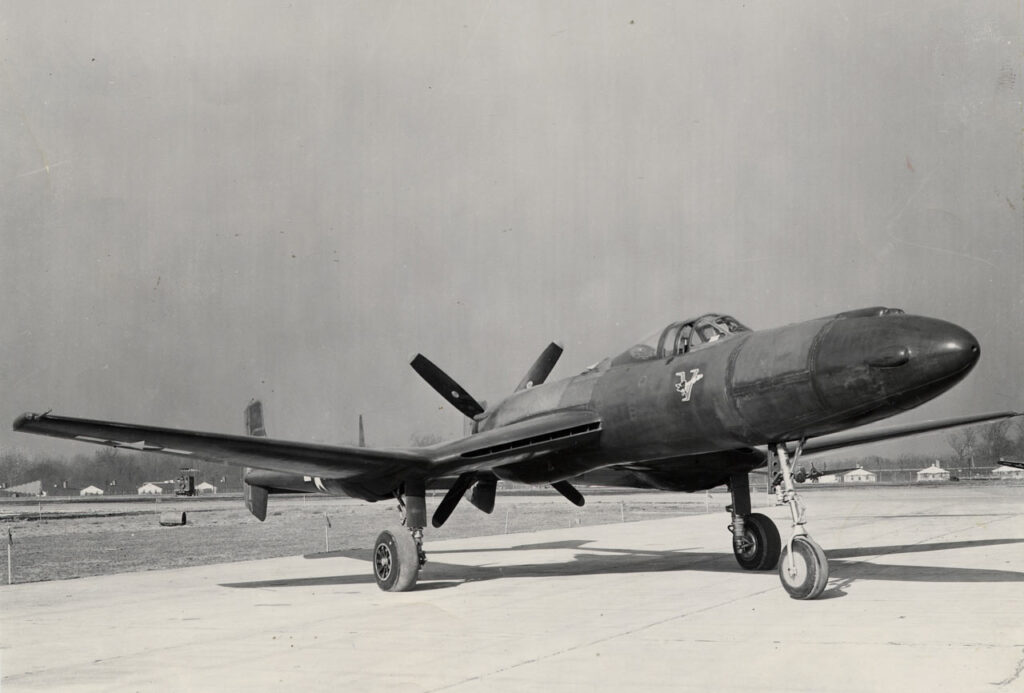 XP-54 No. 11211, the second and last of the prototypes (serial number may actually be 42-108994).
XP-54 No. 11211, the second and last of the prototypes (serial number may actually be 42-108994).
At the same time, existing fighter and interception aircraft designs serving in the USAAF were already seeing success as the war began to turn in the Allies’ favour. The North American P-51 Mustang, Lockheed P-38 Lightning and the Republic P-47 Thunderbolt (which followed more traditional design ideas) had already established themselves as effective fighters by playing a key role in enabling the Allies to gain air superiority over Europe.
Although the pre-war years had allowed for more creativity, there was now little desire to change a conventional design that was already helping the Allied war effort.
Read More Myasishchev VM-T – The Soviet Space Rocket Transporter
In Nazi Germany and Great Britain, newer jet fighter technology had started to come to fruition. Since the 1930s, the British had been researching jet engine capabilities and in 1943 successfully tested and flew the Gloster Meteor jet before it was deployed into active service at the very end of the war. These moves promoted America to invest more into jet technology with future fighter designers over trying to innovate propeller driven fighters.
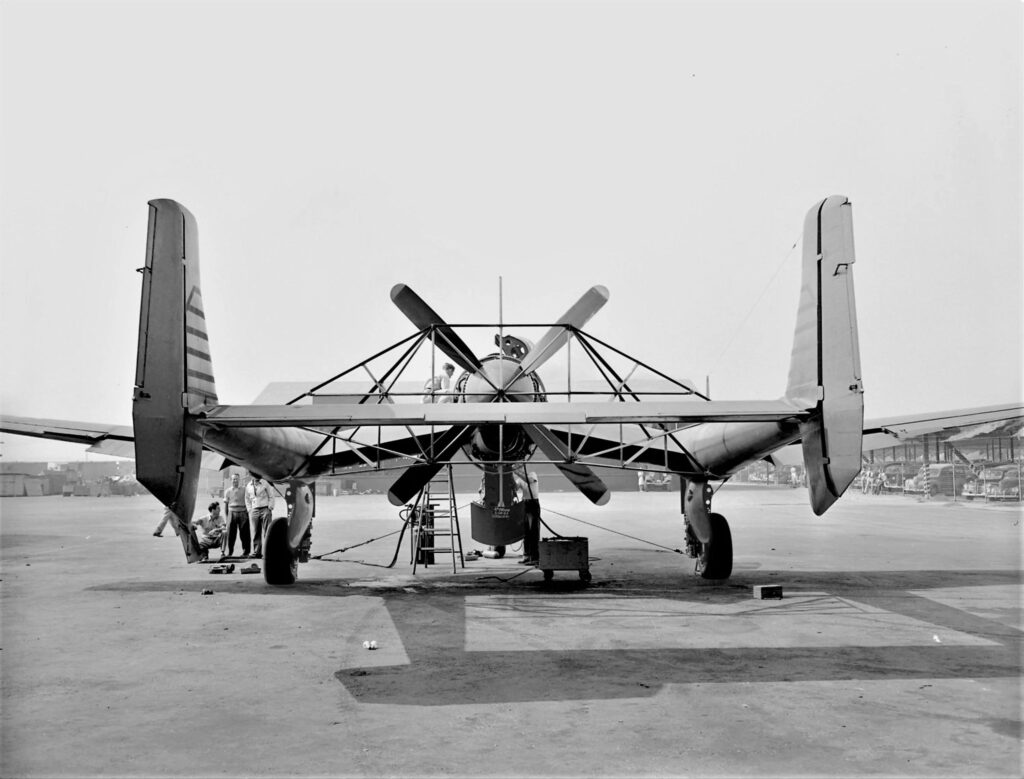 XP-54 No. 11211 fitted with a leveling frame.
XP-54 No. 11211 fitted with a leveling frame.
Even with the XP-58’s advanced turbocharged engine options and its state of the art design features, it was becoming apparently clear that the future of high speed fighter aircraft technology would go in the direction of jet power.
Sadly, both XP-54 Swoose Goose airframes were dismantled and used for scrap metal in 1944 and no surviving examples exist today.
Legacy
Despite its troubled design history and the ultimate termination of the program, the XP-54 remains an important piece of aviation history and a symbol of the innovative spirit of the pre-war era. It also serves as a reminder of the potential of advanced technologies, even when imperfect when first tried, and the challenges engineers face in order to make concept ideas into a reality.
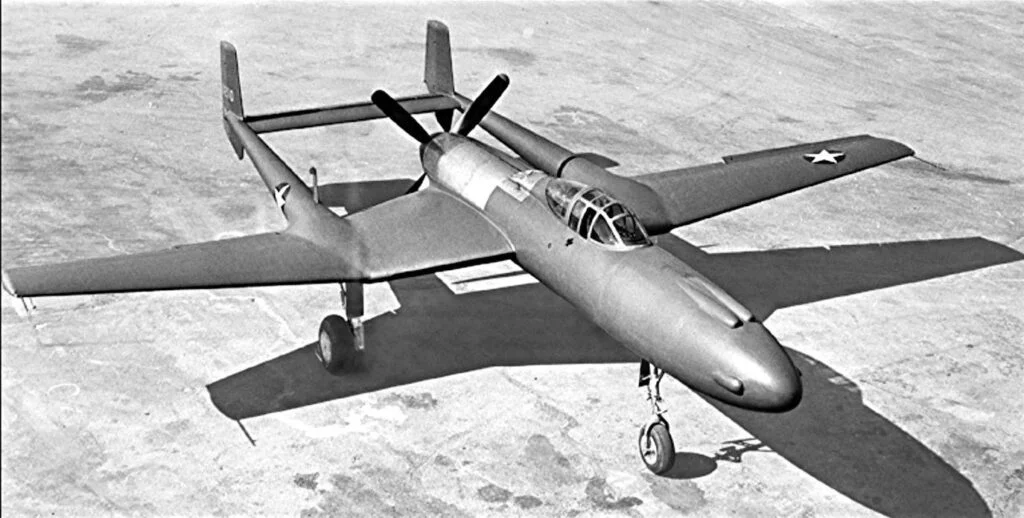 The XP-54 is usually regarded as either extremely ugly, or elegant.
The XP-54 is usually regarded as either extremely ugly, or elegant.
Although there are no physical examples of the XP-54 remaining and the USAAF deemed other existing fighter aircraft to be superior, the Vultee XP-54 was a groundbreaking aircraft that pushed the boundaries of aviation technology during the Second World War.
Read More F-16XL – The Crank Wing Experiment
It is a reminder of the potential of advanced technologies, and the challenges that must be overcome to bring these technologies to life. For aviation enthusiasts and historians, the XP-54 will always be remembered as a fascinating piece of aviation history.
Specifications
- Capacity: 1
- Length: 54 ft 9 in (16.7 m)
- Wingspan: 53 ft 10 in (16.4 m)
- Height: 14 ft 6 in (4.4 m)
- Empty weight: 15,260 lb (6,900 kg)
- Gross weight: 18,230 lb (8,270 kg)
- Powerplant: Lycoming XH-2470, 2,300 hp
- Maximum speed: 381 mph (613 km/h)
- Range: 500 miles (800 km)
- Service ceiling: 37,000 ft (11,300 m)
About The Author
matthew
I have a significant interest in aviation and military history, having graduated with a Master’s degree in modern history at Oxford Brookes University in the United Kingdom. I have worked variously in the education and private business sectors. Outside of work, I enjoy both factual and fiction writing as a hobby. I currently live on the west coast of America and have been working towards obtaining my private pilot’s licence.
Related Post
La desgarradora historia real detrás de la infame fotografía niños en venta; de 1948
El desastre del vuelo de los Andes: un avión que transportaba a 45 personas se estrelló y los supervivientes recurrieron al canibalismo antes de ser rescatados, 1972
Los soldados regresan a casa al final de la Segunda Guerra Mundial. El RMS Queen Elizabeth no estaba abarrotado, los soldados simplemente corrieron hacia la cubierta cuando llegaron a Nueva York.
Los mineros de Charbonnagge de Mariemont-Bascoup se apretujaron en el ascensor de una mina de carbón después de un día de trabajo. Fotografía tomada en Bélgica en c. 1900.
The lives of Chinese people in the late Qing Dynasty through a series of rare photos
Another relic from Alice in Wonderland, a photograph depicting Alice and the dormouse, 1887.